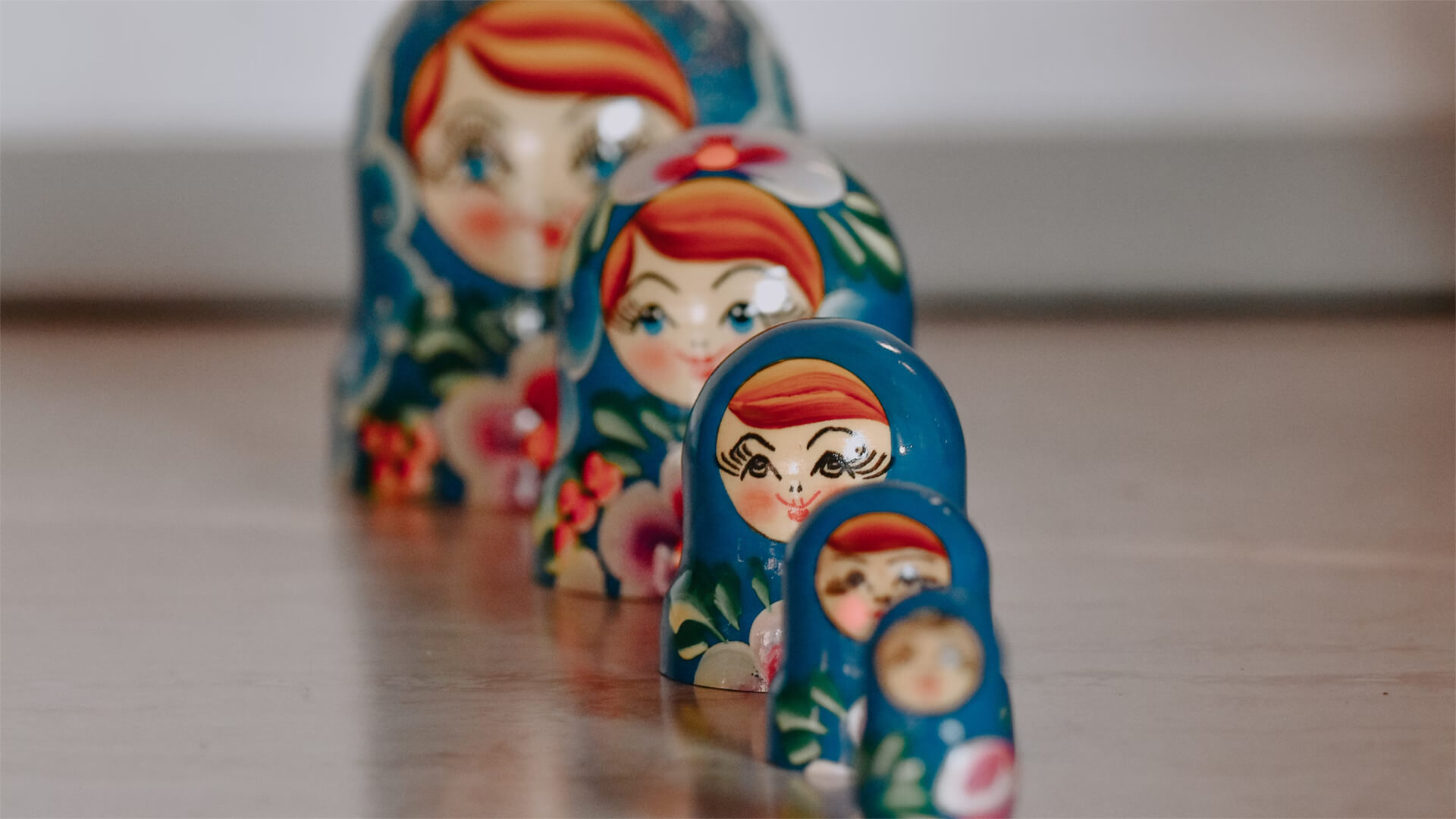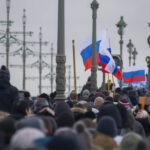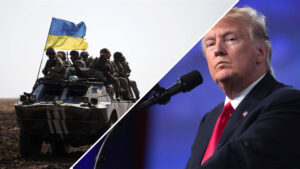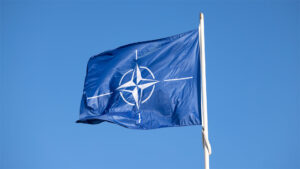Today we’ll be discussing Russian birth and death rates since we’ve got some new Russian demographic data to look at. So, go ahead and grab that truckload of salt.
Russian birth and death rates have fluctuated quite a bit due to major events. The most notable was the demographic “death cross” in the 1990s where deaths outnumbered births; this sent the Russians down a dark path of population decline. Despite some brief recoveries throughout the past few decades, new data out of Russia has confirmed things have worsened.
That recent Russian data is likely overly optimistic, so things are bad. Combine that bleak demographic outlook with no improvements to infrastructure, education, or public health, and you can do the math. Of course, the Ukraine War has accelerated this crisis, as the Russians have sent wave after wave into the meat grinder. That current strategy is unsustainable, but a victory in Ukraine could at least put a little bit of air into the Russians’ lungs. A loss or stagnation would suck even more air out.
Either way, Russia is quickly hacking away at its final opportunity at demographic recovery, which brings long-term viability as a functional state into question.
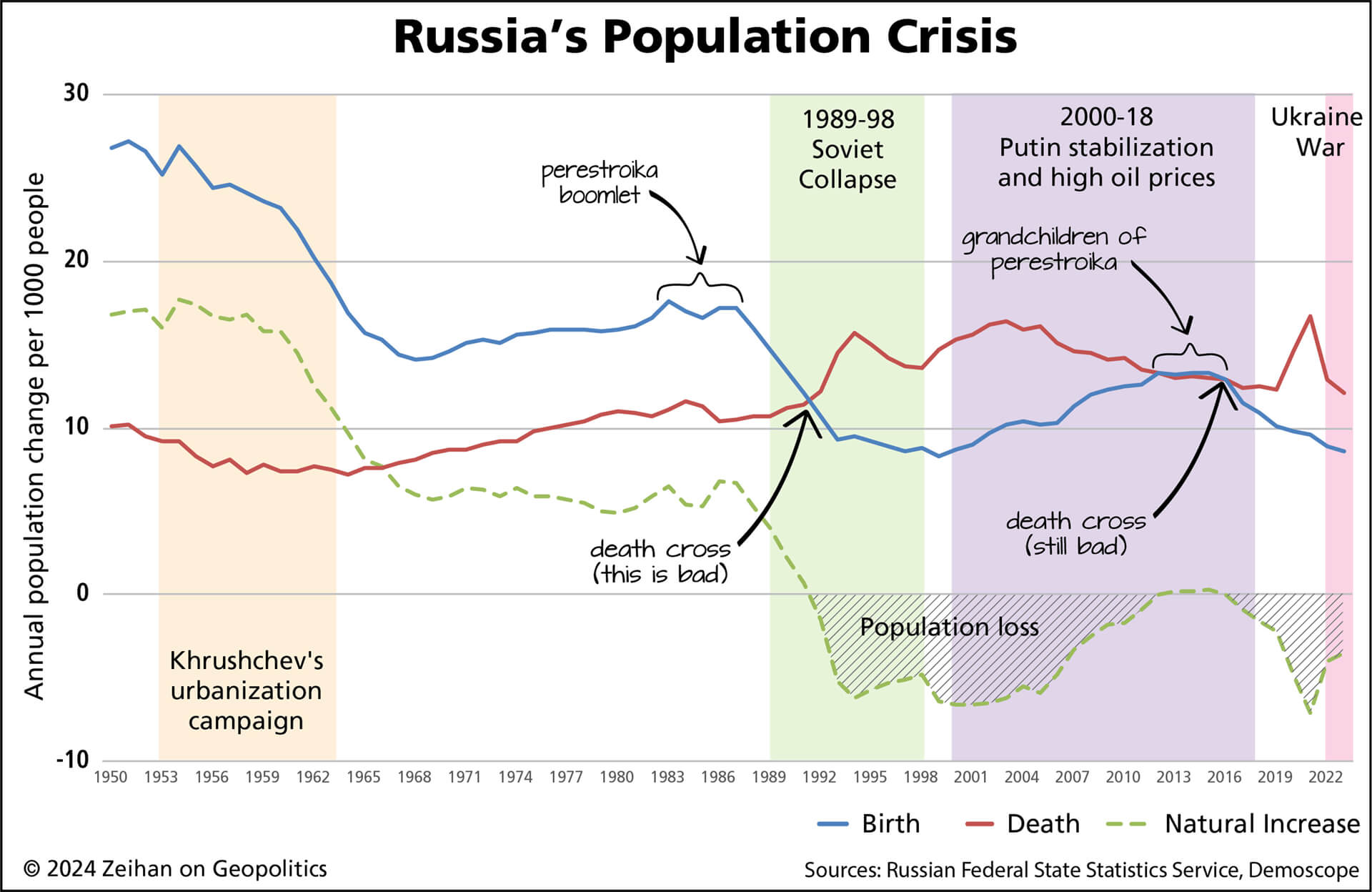
Here at Zeihan on Geopolitics, our chosen charity partner is MedShare. They provide emergency medical services to communities in need, with a very heavy emphasis on locations facing acute crises. Medshare operates right in the thick of it, so we can be sure that every cent of our donation is not simply going directly to where help is needed most, but our donations serve as a force multiplier for a system already in existence.
For those who would like to donate directly to MedShare or to learn more about their efforts, you can click this link.
Transcript
Hey, everybody. Peter Zeihan here. Coming to you from Bell Block, New Zealand. Today we are going to discuss the newest data that’s out from the Russians on their demographics. Russia stopped collecting, demographic data about 17, 18 years ago and have really just been making it up ever since. Now, if you look back through Russian history, there have been a lot of, dark chapters.
And as a rule, when people are depressed, they don’t feel it’s a good idea to have a lot of kids. So these giant rises and dips in the Russian birth rate and death rate, based on what’s going on culturally and economically with the country. Now, the biggest ones, of course, are World War one, World War two. There was a time when Khrushchev tried to shove everyone into small apartments because he thought that was modern, less room for kids. And then, of course, the biggest one is the post-Soviet collapse, when the bottom two, a lot of the Soviet system and we had extended period about 20 years, where basically nothing got better.
You combine this with rampant heroin use and, alcoholism. That is just atrocious by most modern country. Measures, and you get something called a Death cross that happened in the 1990s. And that’s a point when the birth rate and the death rate crossed so that the death rate is higher. And even before you consider incremental mortality issues, you have population shrinkage. Now, a couple of things to keep in mind.
Number one, the Russians back in the mid 80s had this moment of opening and perestroika where we thought maybe, just maybe, we can save the Soviet system. And there absolutely was a little baby boom. And if you fast forward 25, 30 years to just a few years ago, the children of that baby boom, also had kids at a time when Russia was riding high on high energy prices under Vladimir Putin, in the late 2000.
I’m sorry, 20 tens. And so we got another little mini beanie boom. And so that death cross re crossed into a life cross very, very briefly for a very, very low cross. But it was successful and at least for a couple of years bringing the birthrate back up about the death rate. Well with the new data it is clear that that has now reversed.
And remember, this is new data provided by the Russian government is undoubtedly overly optimistic. But even by their own data, they’re now back in the negative territory. All right. So this takes us two places. Number one, none of the underlying issues that have plagued Russia for the last century have gone away. All of them are more intense.
The infrastructure of the Soviet period is still degrading. The Russians have still been unable to rebuild their educational system. Alcoholism is still arise. Drug use is still rife. I’ve run out of speech. Going to go the other way now. And so you shouldn’t expect any improvement because it’s going to be another 25, 30 years before now, the grandchildren of perestroika could be born.
And so you’re dealing more now with the aftereffects of World War one and World War two and oppression and the post-Soviet collapse. And it’s more likely that this period of death is going to be far more intense than what we’ve seen before, because all of the younger people are now older. You know, the boom that they had, say, in the 70s, and they’re just unable to have children now.
The next generation that will be able to have children will be doing it for another 20 years. And second, and far more intensely, is the Ukraine war. As you will notice from this most recent death across it began before the Ukraine war, before Ukraine, or before it began, before the Ukraine war, before Russia became a pariah again, before Russia was under the most extreme sanctions that any major country has ever been on before.
The Russians started seeing massive battlefield casualties. So we are again, in one of those moments in Russian history where people are unsure of their future and they’re not having kids. In addition to the fact that the demographic moment has already passed from the perestroika boom echo, we are already seeing on a daily basis for the last year and a half that more Russian men are dying on the fields of battle in Ukraine than, Russian boys are being born.
And we’ve even had a few days where more men have been dying in the fields of Ukraine than the total number of births – boys and girls.
So We are seeing the Russians waste their last chance to have positive demographic growth ever. And there’s no reason to expect that there’s anything in the Russian system that’s going to improve the, the birthrate or decrease the death rate anytime soon. One of the reasons why Russia has been a major power for so long is numbers.
They have a lot of hope, you know. We’ve had a large country with a lot of ethnic groups and disposing of surplus ethnic groups in the middle of war has long been a Russian strategy for managing their population. They’re doing that now. But you can only do that so long. And that always assumes that you have a robust birthrate, which the Russians don’t anymore.
So the Russians have never been really able to upgrade and update their military strategies in the post-Cold War era to reflect the changes in the demographic picture that just no longer exist and really haven’t existed for decades. So it’s all about lots and lots of artillery. It’s all about what they call meat assaults. It’s human wave tactics, and that works as long as you massively outnumber your foe.
And there are roughly four Russians for every Ukrainian. So it’s not a strategy that is stupid, but is a strategy that if you keep using it when you don’t have a bottomless supply of fighters, that you really eat into what allows your country to exist in the first place. Now, even with this going on, the Russians have more time on their demographic clock than a country like, say, China that has had a rock bottom birth rate now for 40 years.
But when you start burning more people in their 20s than you’re generating babies. You are definitely on a starvation diet. And the question in my mind has always been, when this century, does the Russian ethnicity lose sufficient coherence that it can’t even maintain a state? If they win the Ukraine war, they establish a better external buffer system.
I would say that that would probably be the 2070s or 2080s. But if they become stalled in Ukraine, if they get forced into a piece or a battlefield defeat, that means that they have expended all of the costs of fighting a major war without getting many of the benefits. Then you’re looking at this happening 20, 30, maybe even 40 years earlier.
So, believe it or not, we’re in this weird situation where as long as the Russians are doing this terrific meat assault, it’s really good for the rest of the world. Unless, of course, you happen to be the country that’s on the receiving end. That would be Ukraine. Because it brings forward the day where the Russians just can’t fight any longer at all.


